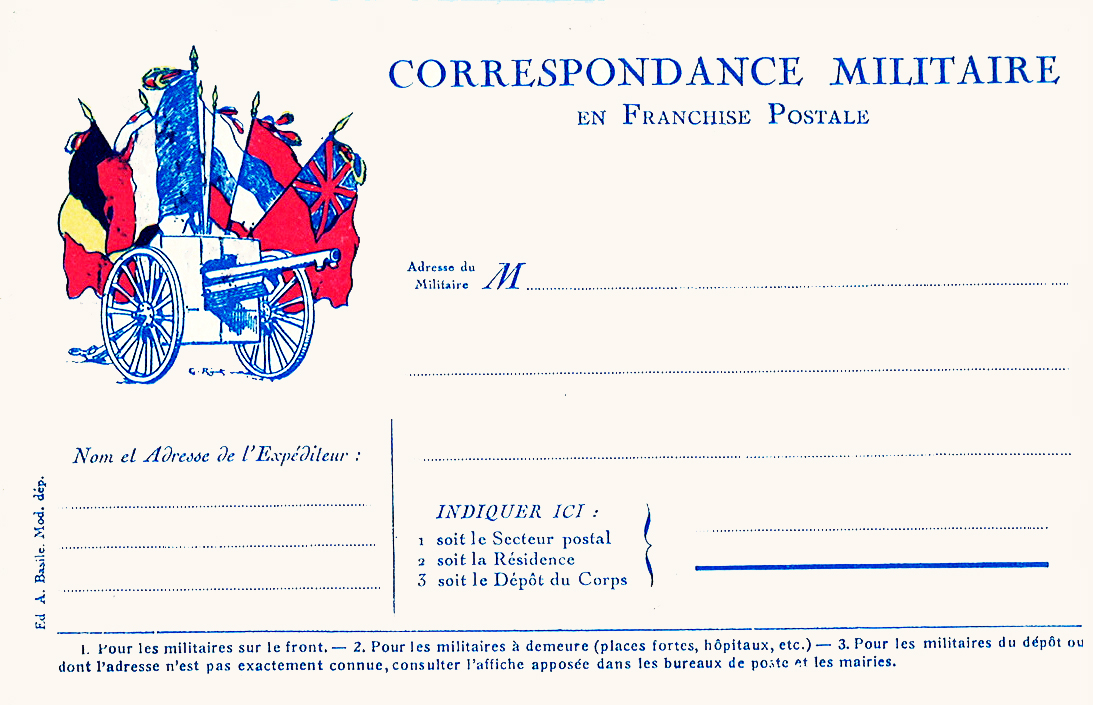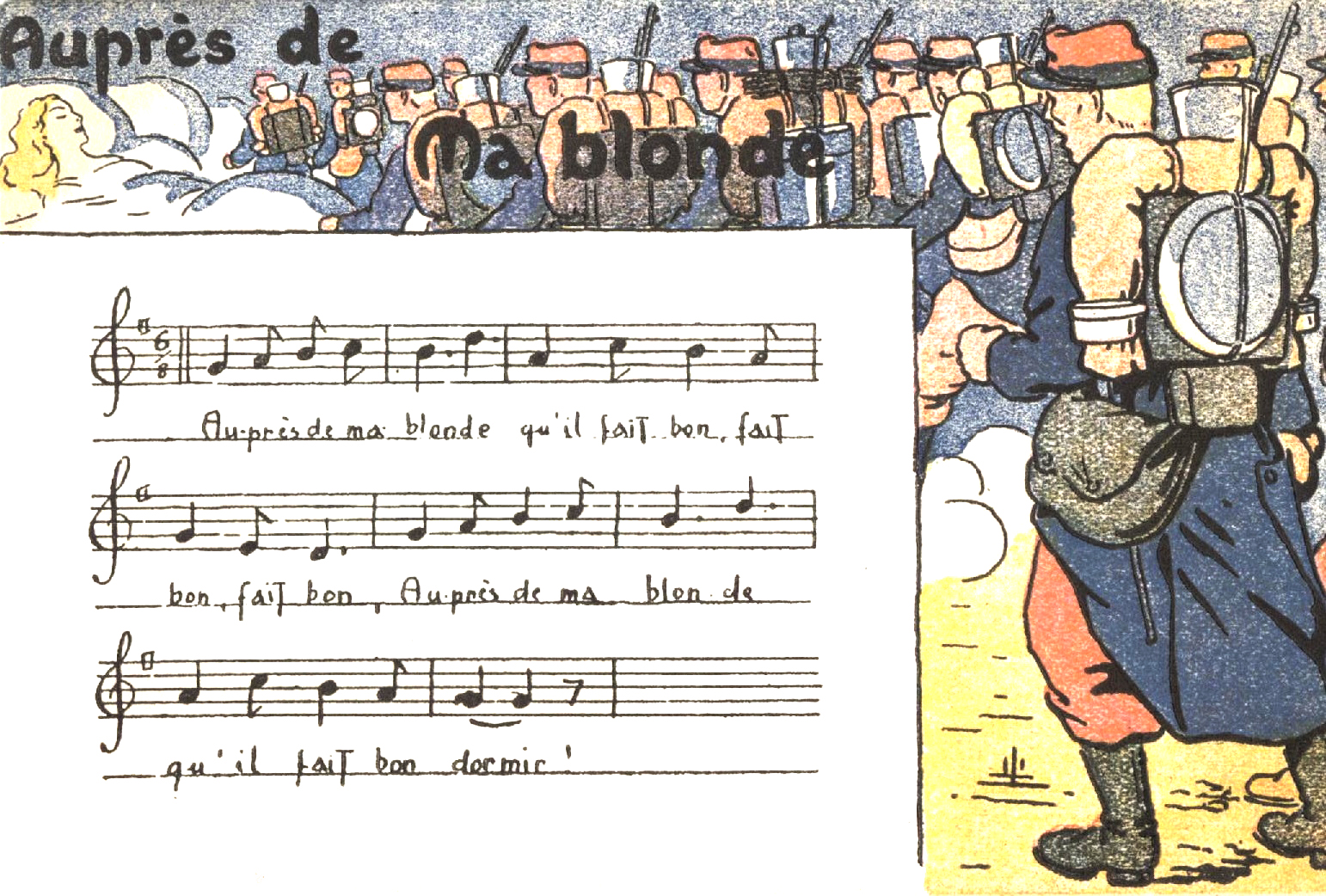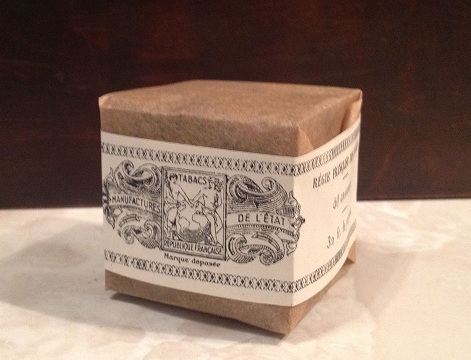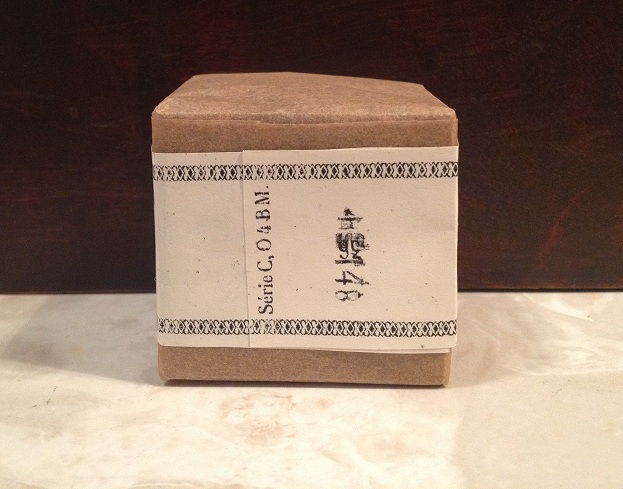Do It Yourself
In an effort to assist reenactors in the development of their impression, the following page contains images of wrappers, labels, and other period imagery that can be printed out using a simple laser or ink printer. After printing, simply cut and paste (the old fashioned way) the images as the case calls for and you're on your way to adding a personal touch to your impression.
Paperwork:
Permission Slip (single)
(Paper type: smooth newsprint - 32lb)
Permission Slip (multiple print out)
(Paper type: smooth newsprint - 32lb)
Blank Writing Paper
(Paper type: smooth newsprint - 32lb. Print PDF as double-sided)
Certificates and Diplomas:
Labels:
ARS Gas Mask Can Label (inside lid):
Lid Label - ARS can (diam: 11.5 cm / 4.5")
Wine & Liquor Labels:
Pinard Wine
1916 Vintage Wine
1918 Vintage Wine
Liqueur
Food:
Camembert Cheese (single)
Camembert Cheese (multiple print out)
Chocolate bars (various)
Sundries:
Railroad tickets (various)
(Paper type: cardstock / coverstock - 67lb)
Currency:
50 cents and 1 franc (Military Scrip) (multiple print out)
5 franc note (multiple print out)
Postage Stamps:
10 Centimes Stamp (red)
10 (plus 5) Centimes Stamp (red)
10 Centimes Stamp (green)
10 Centimes Stamp (multiple print out)
Post Cards:
(Paper type: cardstock / coverstock - 67lb)
Flags of Allied Armies (single)
Flags of Allied Armies (multiple print out)

1915 Poilu (single)
1915 Poilu (multiple print out)

151 RI Miribel Barracks pre-war (single)
151 RI Miribel Barracks pre-war (multiple print out)
Aupres de ma Blonde (single)
Aupres de ma Blonde (multiple print out)
Aupres de ma Blonde - VERSO (multiple print out)

La Marseillase (single)
La Marseillase (multiple print out)

Tobacco Items:
Matchbox (single)
Matchbox (multiple print out)
Rolling Papers Book (single)
Rolling Papers Book (multiple print out)
Tobacco Ration Packet:
The Gros Q was the individual tobacco ration distributed to French troops. Simple in fabrication, it consisted of a brown or tan wax paper wrapper, glued together into a small cube and covered with a ribbon label. It was produced in two sizes: 40 or 100 grams. The tobacco ration was officially called tobac de cantine ("mess hall tobacco") or simply Gros Q ("Big Q"). The soldiers deformed this term to Gros Cul ("Bottom Ass"), as 'Q' and 'Cul' are pronounced the same in French. The 40 gm cubes were issued every other day while the the 100 gm cubes were to be distributed once every five.
Materials:
Instructions:
- Cut out package wrapper from the wax paper. Dimensions = 41/2" x 10"
- Fold wrappers around cube, making sure to firmly crease the paper along all edges
- Apply glue to the long side of wrapper where the ends of the paper meet along one face of the cube. Also apply glue to one short side. When done, the wrapper should be glued closed along its seam and, for our purposes, the base of the package wrapper, so that you now have a cube of paper with only one open end (the "top" of the wrapper).
- While the wrapper is still on the cube, wrap the label around the package, starting with the blank end (i.e. the end without the serial #) evenly centered on the face of the cube, lining the edge of the short end of the label up with the edge of the cube. Make sure to firmly crease the label along all edges.
- Apply glue to the underside of portion of the label that runs across the first two faces of the cube. These portions should be the blank end of the label and the portion of the label that runs over one flap of the "open" end of the wrapper.


Tobacco Ration Label (single)
Tobacco Ration Label (multiple print out - color version)
Tobacco Ration Label (multiple print out - B&W for printing on colored paper)
Addressing Correspondence:
Correspondence sent to a solider assigned to a combat formation required three main pieces of addressee information:
- Soldier’s name (rank optional)
- Soldier's unit (regiment and company required)
- Postal sector number
There were numerous variations on how the soldier’s name and unit were written, with no strict format required. For the soldier’s name, first name -- last name was most common, though last name -- first name, first name initial -- last name, and first name were also written, Middle names and confirmation names were also written sometimes. The soldier's name was typically preceded by the man’s rank (sometimes abbreviated) or simply a capital letter “M.” (abbreviation of “Monsieur”). Typical abbreviations of rank include the following:
Soldat = Sdt.
Caporal = Cpl.
Sergent = Sgt.
Adjudant – Adj.
Lieutenant = Lieut., Lt.
Capitaine = Capt., Cpt.
Colonel = Col.
General = Genl., Gen.
Naturally, there were variations on what was included for the unit designation and how this was written. It should be noted first that any reference to brigade, division or army corps was strictly prohibited. Therefore, the first unit specified was the regiment, which naturally was a mandatory piece of information. Sometimes the battalion was specified. Otherwise, the next mandatory inclusion was the company number. Occasionally the section and/or squad number was provided. Perhaps due to the inherently temporal nature of these last unit designations (especially the squad), these were not always specified. Typical abbreviations of the various units include the following:
Regiment = Rég't, Régm't, Régim't, R.I., etc.
Battalion = Batt., Bat., Bat'l, etc.
Compagnie = Co., Cie., etc.
Section = Sect., Sec.
Esquoade = Esc.
The secteur postal was the final piece of information required, which was either written out in full or abbreviated as “S.P.” There were a total of 236 postal sectors (1-223, 501, 502, 503A, 506, 508, 508A, 509, 509B, 510, 512, 513, 515, 517). For the infantry combat formations, these were assigned at the division level, so that each infantry division had it’s own unique S.P. assigned to it. A note to members of the 151 R.I., the regiment was under S.P. 35 from 1914 to January 1917 (42 D.I.), then S.P. 124 from January 1917 until the end of the war (69 D.I.).
The following are examples of how to address correspondence:
M. Jean Bouchez
Soldat au 151e Régiment d'Infanterie
1e Cie., 3e Section
Secteur Postal No. 124
Soldat G. Maillard
151e R.I.
3e Batt. - 11e Co.
S.P. 124
Cpl. Mathieu Picard
151e Rég't
9e Cie., 1e Sect., 4e Esc.
Secteur Postal 124
The return address (the sender) invariably included:
- Sender’s name
- Street address (if extant)
- Town/city
- Department
The following are examples of how to address correspondence:
M. Paul Lintier
14 r. Santieul
Eloyes
Vosges
Mde. E. Dupuis
3, rue de Wavrin
Santes
P-de-C
L. Fagot
Liouc
Gard
M. Maurice Conflans
35 rue de Lappe
Paris – 12 arr.
Horizon-Blue Paint:
The following paint code is from Lowe's paint but can likely be provided to any standard paint or hardware store to be used for making horizon-blue paint. The resulting paint is an egg-shell slate-blue more representative of the darker shades of HB:
Lowe's Valspar - Base 4-34143; Tint: 101-11.5, 102-14.75, 107-5, 113-4.25
Poilu Coloring Page for Kids:
A print out of a cartoon image of a poilu for kids to color in on their own. Perfect for living histories with the public:
Poilu Coloring Page


